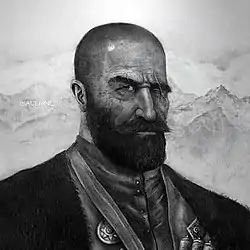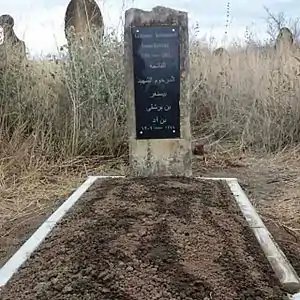Baysangur of Benoa
Baysangur of Beno (Chechen: Бенойн БойсгӀар)[1] (born 1794, Benoy, Vedensky District, Chechnya – died 3 March 1861, Khasavyurt, Chechnya) was a 19th-century Chechen commander. He was one of the naibs of Imam Shamil.[2] Baysangur participated in the Caucasian War of 1817–1864.[2]
Baysangur of Beno | |
|---|---|
 | |
| Native name | Бенойн БойсгӀар |
| Nickname(s) | "Tash Adam" (Man of Stone) |
| Born | 1794 Benoy, Chechnya |
| Died | March 3, 1861 Khasavyurt, Chechnya |
| Buried | Yaryksu-Auh |
| Allegiance | Chechnya ? - 1840
Caucasian Imamate 1840 - 1859 Chechnya 1859 - 1861 |
| Rank | Naib of Imam Shamil 1840 - 1859 Imam of Chechnya 1859 - 1861 |
| Battles/wars | Caucasian War |
Biography
Baysangur belonged to the Beno Teip from Edi Nek'e. In 1825-1826 Baysangur took part in the uprising led by Beibulat Taimiev.[3] In 1828, when Gazi-Muhammad was proclaimed imam, he joined his movement.[4] Aul Benoy became the mainstay of Gazi-Muhammad in Chechnya.[5] In 1839, his family received the defenders of Akhulgo, Shamil and his murids.[6]
Naib of imam Shamil
By 1846, in battles with the Russian troops of Count M.S.Vorontsov, naib lost an arm and an eye, and in 1847, in the battles for Gergebil, his leg was blown off by a cannonball. As a result of such a serious injury, he was captured by the tsarist troops, from which he was rescued by Shamil's murids, who attacked the convoy that transported Baysungur to the Grozny fortress. According to popular legends, so that he could stay in the saddle, he was tied to a horse.[7]
On August 25, 1859, after the siege of the fortress, Gunib Imam Shamil decided to surrender. After the surrender of Shamil prisoner Baysangur with his party broke through the encirclement and left the king's troops in Caucasus.[1][8]
On May 8, 1860, Baysangur and former naibs Shamil Uma Duev, and Atabi Atayev raised a new uprising in Chechnya. In June of the same year Baysangur's squad defeated the Russian Ossetian Muslim Major-General Musa Kundukhov in combat near the town Fachu. Atabi Atayev's rebels thwarted attempts to strengthen Evdokimovsky, and the Duev's attachment was freed from the Russian villages of the Argun Gorge. General rebel forces reached at that moment 1,500 people. In November, they moved against eight hundred Cossacks, 9 infantry battalions, and four rifle companies.
Baysangur's zeal and courage was noted by Imam Shamil in the diary of his bailiff Colonel A. I. Runovsky:[9]
After a good dinner, when the younger members of the imam's large family left the dining room, the eldest of Shamil's sons, Gazi-Mohammed, who had recently returned from Temir-Khan-Shura, began to tell the latest news from the Caucasus. At the end of the conversation, Gazi-Muhammad mentioned a small episode related to the indomitable Chechen naib Baysangur from Benoi, who, even after the surrender of Imam Shamil, did not stop resistance and did not lay down his arms, continuing the fight along with his other brothers in arms, now former Chechen naibs of Shamil - Uma Duyev and Atabi Atayev.
Adjutant wing Colonel Chertkov sent negotiators on behalf of the Russian command to Baysangur with a proposal to surrender, - said Gazi-Muhammad. Baysangur met the negotiators in the woods near the old cemetery. In response to a tempting offer to save his life, the one-eyed, one-armed and one-legged sixty-six-year-old warrior pointed to the nearest graves in the cemetery and said with a grin: “Talk to them about your case - they will hear you better than me.
Shamil, who was attentively listening to his son's story, said thoughtfully: - Yes, this is such a person, I know him well, he would never change his word ... For a moment, the former imam thought he heard the howling of wolves from the very depths of the dense Chechen forests. And as if shaking off this obsession, he resolutely added: - But, however, he wants nothing more than to die fighting against the infidels.
— Andrey Zakharovich Runovskiy, Diary of Colonel Runovsky

Death
Alarmed by the uprising of Baysangur, the Russian Army decided to make immediate action. With assists from Musa Kundukhov, Nikolai Kolovachyov and Artsu Chermoyev, the Russian Army started to round up around the village of Bergatoy thanks for earlier intelligence information of Baysangur's location. Kundukhov used brute force and extreme brutality to crush every Chechen villages remaining, resulting with 15 villages destroyed. Losing the hideout, Baysangur and his men returned to Benoy, tried to keep the resistance, but it was eventually crushed and they were captured, including Baysangur.[10][11]
Baysangur was imprisoned in Khasavyurt and was later sentenced to death by hanging by authority of Major General Pavel Kempert. He was hanged on March 1, 1861.[12]
Since his death, his story of the famed last stand against Russian Army has been popular among Chechens as an example of Chechen heroism.
Memory and image in popular culture
- In a number of settlements of the Chechen Republic and Dagestan there are streets named after Baysangur Benoevsky.
- The image of Baysangur is depicted in the historical novel by Abuzar Aydamirov "Long Nights"
- Song of Imam Alimsultanov for acoustic guitar "Gunib" (1991) is dedicated to the defense of Gunib and the participation of Baysangur Benoevsky in these events
- Chechen bard Timur Mutsurayev dedicated to Baysangur a song of the same name from 1997, as well as the song "Gunib" (1998), in which Baysangur appears, dedicated to the defense of Gunib.
References
- Ш.А. ГАПУРОВ, А.В. БАКАШОВ. Вестник Академии наук Чеченской Республики. 2010, №1 (12). Archived 2016-01-13 at the Wayback Machine
- Гапуров Ш. А.; Ахмадов Ш. Б.; Багаев М. Х.; Хасбулатов А. И. (2008). "Глава XXIII. народно-освободительное движение в Чечне в 60-90 гг. XIX в. § 1. Вооружённое восстание в 1860-1861 гг.". История Чечни с древнейших времен до наших дней. Том I. История Чечени с древнейших времен до конца XIX века (2е изд., испр., 3000 экз ed.). Грозный: ГУП «Книжное издательство». Под ред. М. М. Ибрагимова. T. 1, pp. 685–695. ISBN 978-5-98896-103-1.
- "Шамиль: от Гимр до Медины". www.universalinternetlibrary.ru. Retrieved August 28, 2020.
- "Д. Хожаев. Чеченцы в Русско-Кавказской войне". ИА Чеченинфо (in Russian). Retrieved August 28, 2020.
- Istorii︠a︡ Chechni s drevneĭshikh vremen do nashikh dneĭ. Ibragimov, M. M. (Movsur Muslievich), Ибрагимов, М. М. (Мовсур Муслиевич) (2. izd., ispr., dop ed.). Groznyĭ: Knizhnoe izdatelʹstvo. 2008. ISBN 978-5-98896-103-1. OCLC 354975469.CS1 maint: others (link)
- Gadzhiev, Bulach.; Гаджиев, Булач. (1992). Shamilʹ ot Gimr do Mediny. Makhachkala: Dagestanskoe knizhnoe izd-vo. ISBN 5-297-00992-8. OCLC 30988479.
- Gadzhiev, Bulach.; Гаджиев, Булач. (1992). Shamilʹ ot Gimr do Mediny. Makhachkala: Dagestanskoe knizhnoe izd-vo. ISBN 5-297-00992-8. OCLC 30988479.
- Далхан Хожаев. Чеченцы в Русско-Кавказской войне. Archived 2014-12-22 at the Wayback Machine Издательство «СЕДА» 1998 ISBN 5-85973-012-8
- Акты, собранные Кавказской Археографической комиссией : [В 12-ти т.] / Арх. гл. упр. наместника Кавк.; Под общ. ред. А. Д. Берже. - Тифлис : Тип. гл. упр. Наместника Кавк., 1866-1904. Т. 12 : [1856-1862] / Арх. Канц. Главноначальствующего; Под ред. Е.Д. Фелицына и А.П. Наумова. - Тифлис : Тип. канц. главнонач. гражд. частью на Кавказе, 1904. - [1552 c.] Тифлис: Тип. канц. главнонач. гражд. частью на Кавказе. 1904. p. 1454.
- РГВИА. ф. ВУА. Д.6684, л.10 и об.
- отв. ред. М. С. Тотоев]; Чечено-ингушский научно-исследовательский ин-т истории; языка и литературы при Совете министров Чечено-ингушской АССР, eds. (1967). "Очерки истории Чечено-Ингушской АССР: с древнейших времен до наших дней: в 2-х томах". 1.: С древнейших времен до марта 1917 года. 4000. Грозный: Чечено-Ингушское книжное изд-во. pp. 126–127.
- Ибрагимова З. Х. (2007), "Антиправительственные выступления чеченцев", Мир чеченцев. XIX век, М.: Пробел-2000, p. 562, ISBN 978-5-457-95834-0
| Wikimedia Commons has media related to Baysangur of Benoa. |